用结构体数据的安全性得不到保证。
使用类对数据进行封装,只能通过函数修改类中的数据
(1)类的定义
class 类名 { private: protected: public: };
private:定义私有成员,只能被类本身的成员函数和友元访问。派生类和其他类均不能访问。若数据没有指明类型,默认为私有。
public:定义公有成员,可被程序中任何代码访问。
protected:定义保护成员,能被本身成员函数,友元,派生类访问。
(2)成员函数的定义
a、在类中定义
#include<iostream> #include<cstdio> #include<cstring> #include<algorithm> using namespace std; class Student { private: string Name; float Phi,Math,Ave; public: void set(string name,float phi,float math) { Name=name; Phi=phi; Math=math; } void Average() { Ave=(Phi+Math)/2; } void Display() { cout<<Name<<" "<<Phi<<" "<<Math<<" "<<Ave; } }; int main() { Student stud; stud.set("zhangsan",90,100); stud.Average(); stud.Display(); return 0; }
b、在类外定义
(考虑到有些函数复杂,在类内写不好看)
先在类内声明,然后在类外定义的形式是
函数返回值类型 类名 ::函数名称()
{}
#include<iostream> #include<cstdio> #include<cstring> #include<algorithm> using namespace std; class Date { private : int year,month,day; public: void setDate(int,int,int); bool IsLeap(); void print() { cout<<year<<" "<<month<<" "<<day<<endl; } }; void Date::setDate(int n,int y,int r) { year=n;month=y;day=r; } bool Date::IsLeap() { if(year%400==0||year%4==0&&year%400) return true; return false; } int main() { Date dt; dt.setDate(2019,11,22); if(dt.IsLeap()) cout<<"yes "; else cout<<"no "; dt.print(); return 0; }
(3)成员的访问
a、对于数据成员的访问
对象名.成员名 对象指针名->成员名 (*对象指针名).成员名
b、对于成员函数的访问
对象名.成员函数名(参数表) 对象指针名->成员函数名(参数表) (*对象指针名).成员函数名(参数表)
#include<iostream> #include<cstdio> using namespace std; class Student { private : string name; float Math,Phi,Ave; public: void setDate(string nam,float math,float phi) { name=nam; Math=math; Phi=phi; } void Average() { Ave=(Math+Phi)/2; } void print() { cout<<name<<" "<<Math<<" "<<Phi<<" "<<Ave<<endl; } }; int main() { Student stu,*stud; stud=&stu; //一开始我没定义 stu,直接定义个指针用了,这样不行。 stud->setDate("zhangsan",100,90); stud->Average(); stud->print(); return 0; }
#include<iostream> #include<cstdio> using namespace std; class Student { private: string Name; int Phi,Math; public: void setDate(); void print() { cout<<Name<<" "<<Phi<<" "<<Math<<endl; } }; void Student::setDate()//在类作用域内,直接使用即可访问 { cin>>Name>>Phi>>Math; } int main() { Student stud; stud.setDate(); stud.print(); return 0; }
(4)构造函数
构造函数就是对类内的数据初始化,定义一个类的对象时自动调用,如果不写构造函数,就调用系统默认的构造函数。
性质:与类名相同 无返回值 可以重载
#include<iostream> #include<cstdio> using namespace std; class Cuboid //长方体类 { private: int length,width,height; public: Cuboid();//无参构造函数 Cuboid(int,int,int);//有参构造函数 int volume();//计算体积 }; Cuboid::Cuboid() { length=width=height=1; } Cuboid::Cuboid(int l,int w,int h) { length=l; width=w; height=h; } int Cuboid::volume() { return length*width*height; } int main() { Cuboid cuboid1; cout<<"cuboid1的体积为:"<<cuboid1.volume()<<endl; Cuboid cuboid2(10,20,30); cout<<"cuboid2的体积为:"<<cuboid2.volume()<<endl; return 0; }
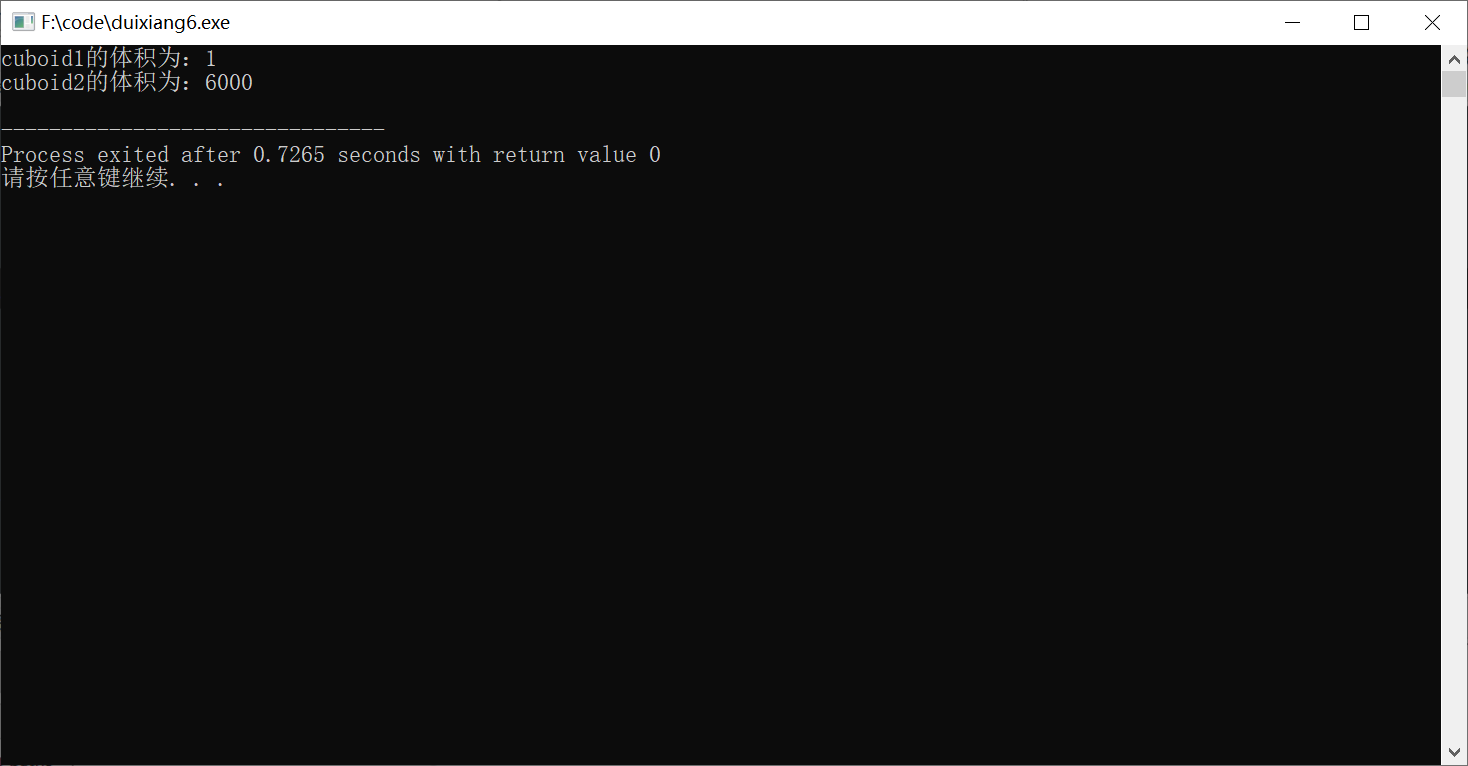
#include<iostream> #include<cstdio> using namespace std; class Cuboid { private: int h,w,l; public: /* Cuboid(int hh=10,int ww=20,int ll=30)另一种写法 { h=hh;w=ww;l=ll; }*/ Cuboid(int hh=10,int ww=20,int ll=30);//声明时有默认参数 int volume() { return h*w*l; } }; Cuboid::Cuboid(int hh,int ww,int ll)//不用再写默认参数 { h=hh; w=ww; l=ll; } int main() { Cuboid cuboid1; cout<<cuboid1.volume()<<endl; Cuboid cuboid2(1); cout<<cuboid2.volume()<<endl; Cuboid cuboid3(1,2); cout<<cuboid3.volume()<<endl; return 0; }
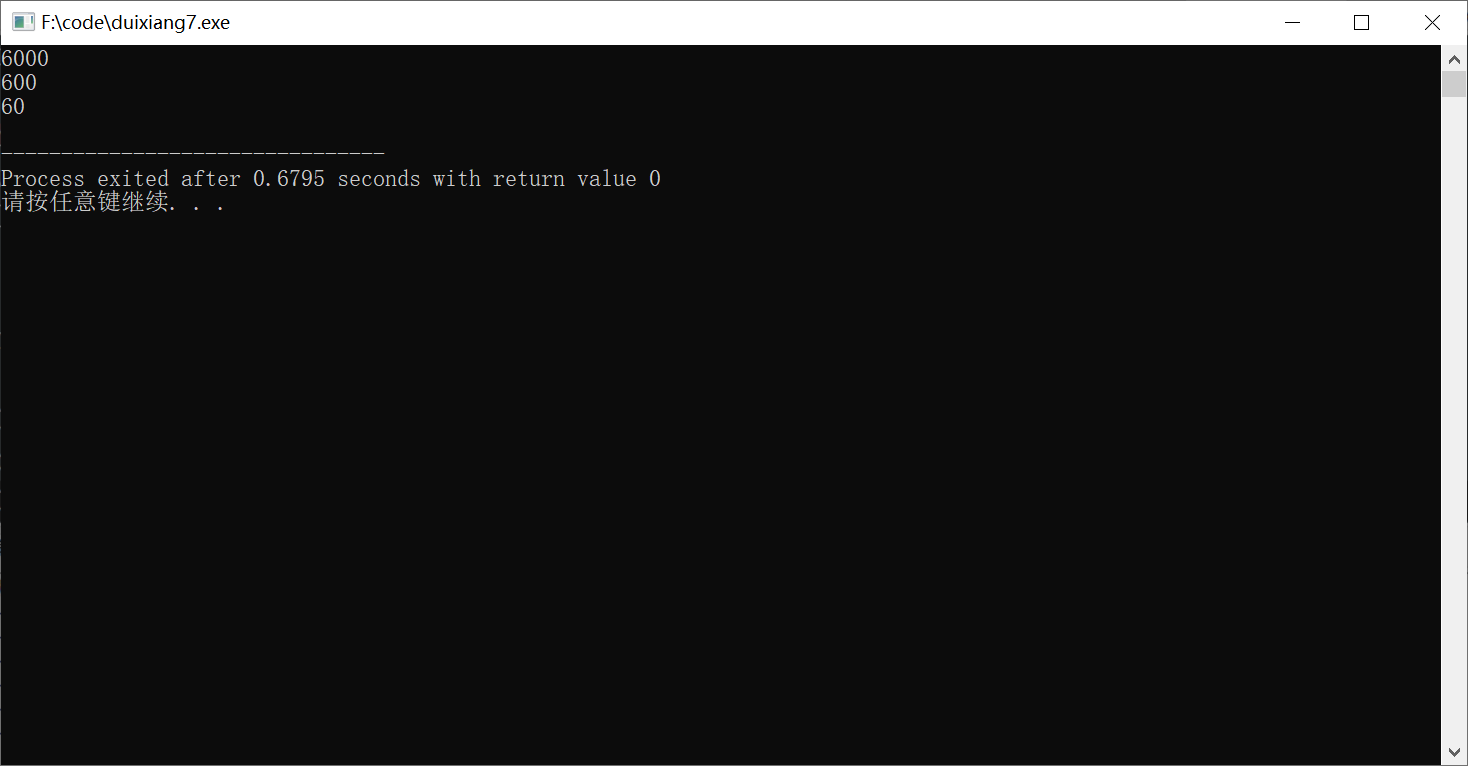
也可以这样初始化
Cuboid(int h,int w,int len):height(h),width(w),length(len){}
(5)拷贝构造函数
拷贝构造函数的名称与类名一致,函数的形式参数是本类型的一个引用变量。
Sample (Sample &S);
对象1=对象2 //对象1和对象2必须是同一个类
将一个对象的非静态数据成员的值一一赋值给另一对象的对应成员。
Sample S2(S1);
Sample S2=S1;两者等价
a、
#include<iostream> #include<cstdio> using namespace std; class Sample { private: int data; public: Sample(int dt) { data=dt; } void print() { cout<<data<<endl; } }; int main() { Sample s1(100); Sample s2=s1; s2.print(); }
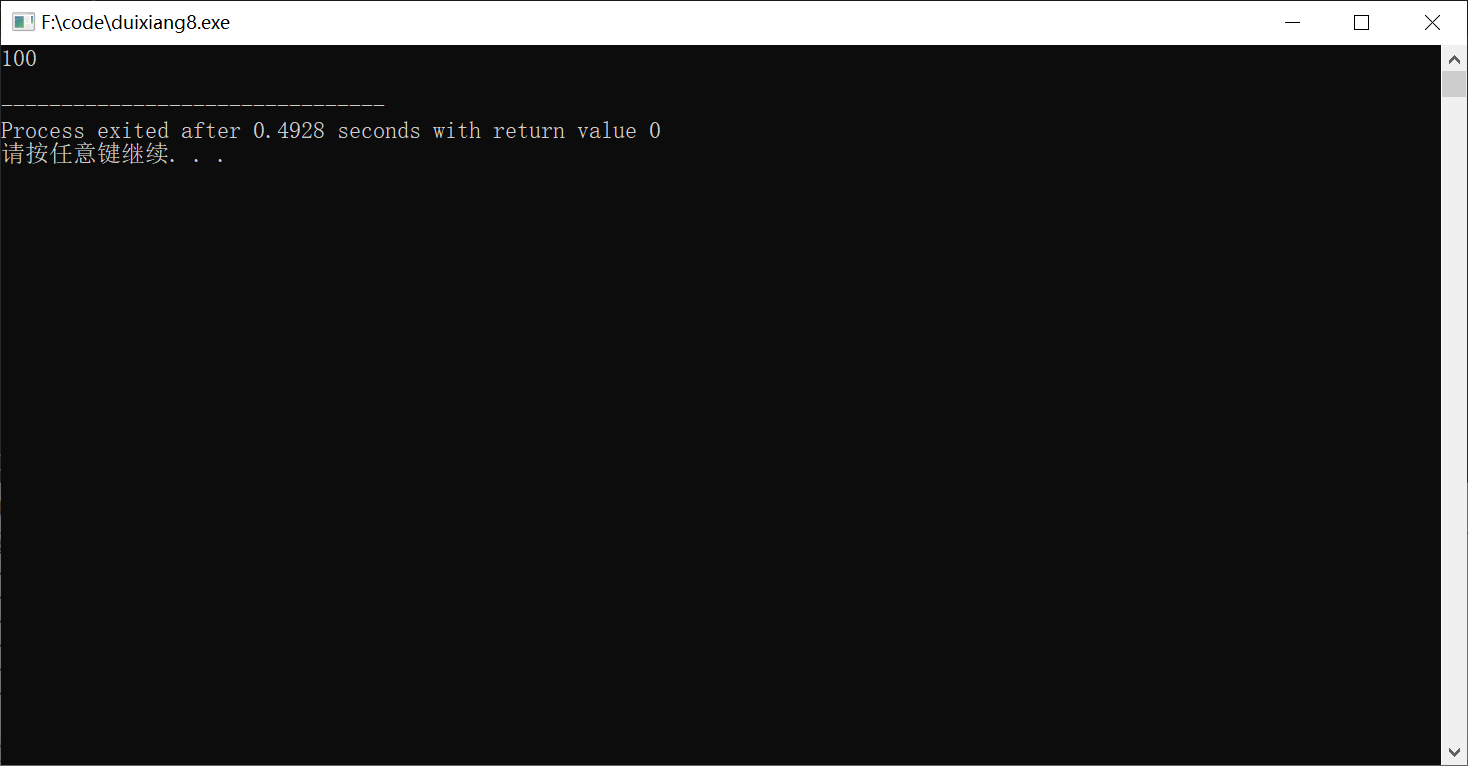
b、自定义拷贝构造函数 并不是一一赋值
#include<iostream> #include<cstdio> using namespace std; class Sample { private: int a,b,c,d; public: Sample(int aa,int bb,int cc,int dd) { a=aa;b=bb;c=cc;d=dd; } Sample(Sample &S) { a=S.a;b=S.b;c=S.c; d=S.d+1; } void print() { cout<<a<<" "<<b<<" "<<c<<" "<<d<<endl; } }; int main() { Sample dt1(1,2,3,4); Sample dt2=dt1; //Sample dt2(dt1); dt2.print(); return 0; }
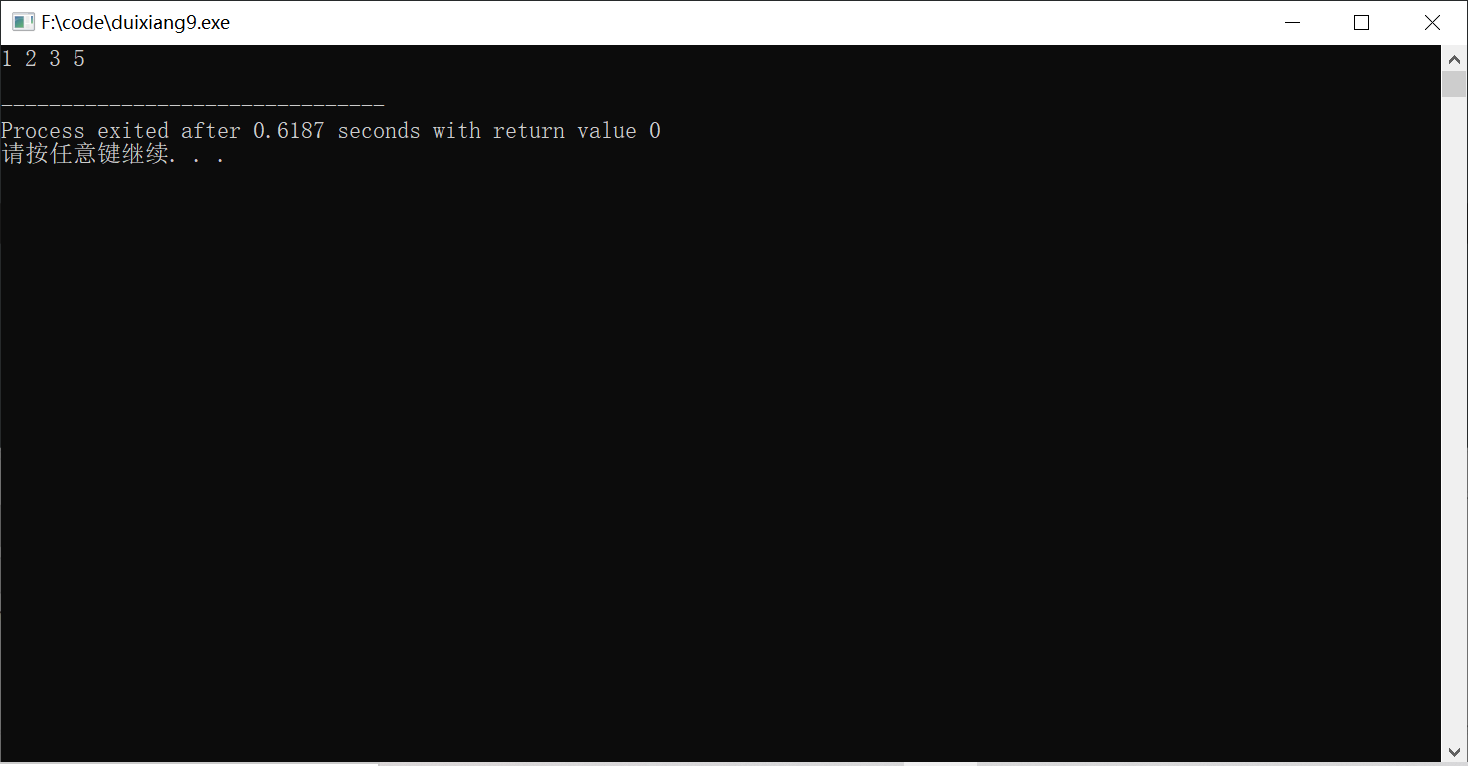
(6)析构函数
作用在对象脱离作用域时释放相关资源,清理善后工作。
析构函数名和类名相同只是在函数名前面加~符号
无参数 无返回值 只能有一个析构函数 不写虚构函数调用系统自己的
#include<iostream> #include<cstdio> using namespace std; class Cstudent { private: int num; string name; public: Cstudent(string nam,int nnum) { name=nam; num=nnum; cout<<name<<" Constructor called. "; } void display() { cout<<"学号:"<<num<<endl; cout<<"姓名:"<<name<<endl; } ~Cstudent() { cout<<name<<" Destructor called "; } }; int main() { Cstudent stud1("zhangsan",1); Cstudent stud2("lisi",2); return 0; }
一般情况下,调用析构函数的次序与调用构造函数的次序相反。
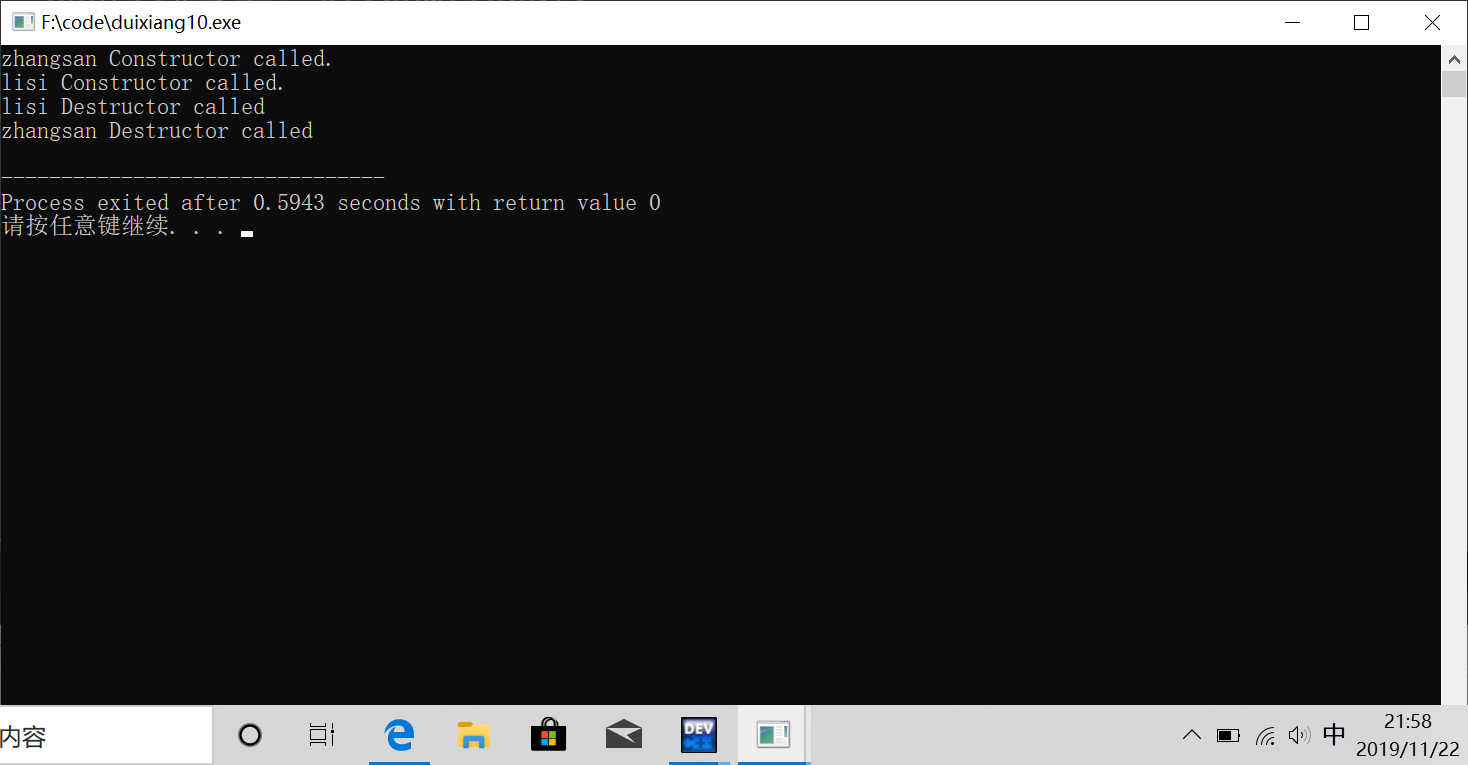
(7)静态成员--静态数据成员
静态数据成员被类内所有的对象共享,某个对象对静态数据成员做出修改,则其他所有对象也共享被修改后的值。
静态数据成员的存储空间不会随着对象的产生而分配,也不会随着对象的消失而释放。
因此,静态数据成员不能在类体内初始化。
如果未对静态数据成员赋初值,默认为0;其他成员不会默认为0;
class Cstudent { private: string name; int score; static int studenttotal; static int sumscore; public: Cstudent(string nam,int scor) { name=nam; score=scor; studenttotal++; sumscore+=scor; cout<<name<<" Constructor called. "; } static float average(); ~Cstudent(); }; int Cstudent::studenttotal=0; int Cstudent::sumscore=0;
(8)静态成员--静态成员函数
一般情况下,静态成员函数只访问静态成员。也可以访问非静态成员,但要指明其所属对象,但这样麻烦,所以不用。
class Cstudent { private: string name; int score; static int studenttotal; static int sumscore; public: Cstudent(string nam,int scor) { name=nam; score=scor; studenttotal++; sumscore+=scor; cout<<name<<" Constructor called. "; } static float average();//******* ~Cstudent(); }; int Cstudent::studenttotal=0; int Cstudent::sumscore=0; float Cstudent::average() //********** { return (sumscore*1./studenttotal); }
静态成员的访问
一般是:类名::静态数据成员名
#include<iostream> #include<cstdio> using namespace std; class Cstudent { private: string name; int score; static int studenttotal; static int sumscore; public: Cstudent(string nam,int scor) { name=nam; score=scor; studenttotal++; sumscore+=scor; cout<<name<<" Constructor called. "; } static float average();//******* ~Cstudent(); }; int Cstudent::studenttotal=0; int Cstudent::sumscore=0; float Cstudent::average() //********** { return (sumscore*1./studenttotal); } Cstudent::~Cstudent() { studenttotal--; sumscore-=score; cout<<name<<" Destructor called. "; } int main() { Cstudent stud[2]={Cstudent("zhangsan",90),Cstudent("wangwu",100)}; cout<<Cstudent::average()<<endl; return 0; }
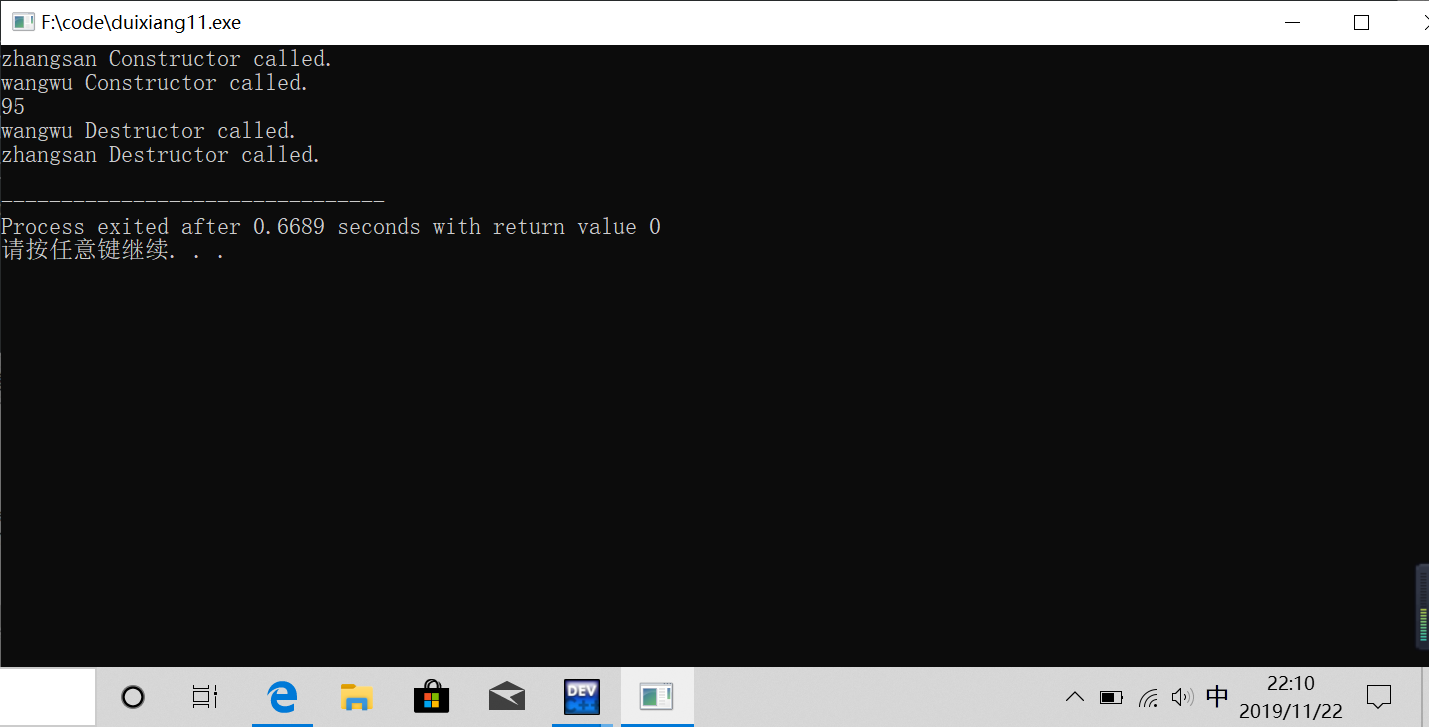
(9)对象的存储
只有数据成员占有的内存空间的大小,而没有包括成员函数。
//类的空间 #include<iostream> #include<cstdio> using namespace std; class Data { private: int a,b; public: void setdata(int aa,int bb) { a=aa; b=bb; } void print() { cout<<a<<" "<<b<<endl; } }; int main() { Data x,y; cout<<sizeof(int)<<endl; cout<<sizeof(x)<<endl; return 0; }
()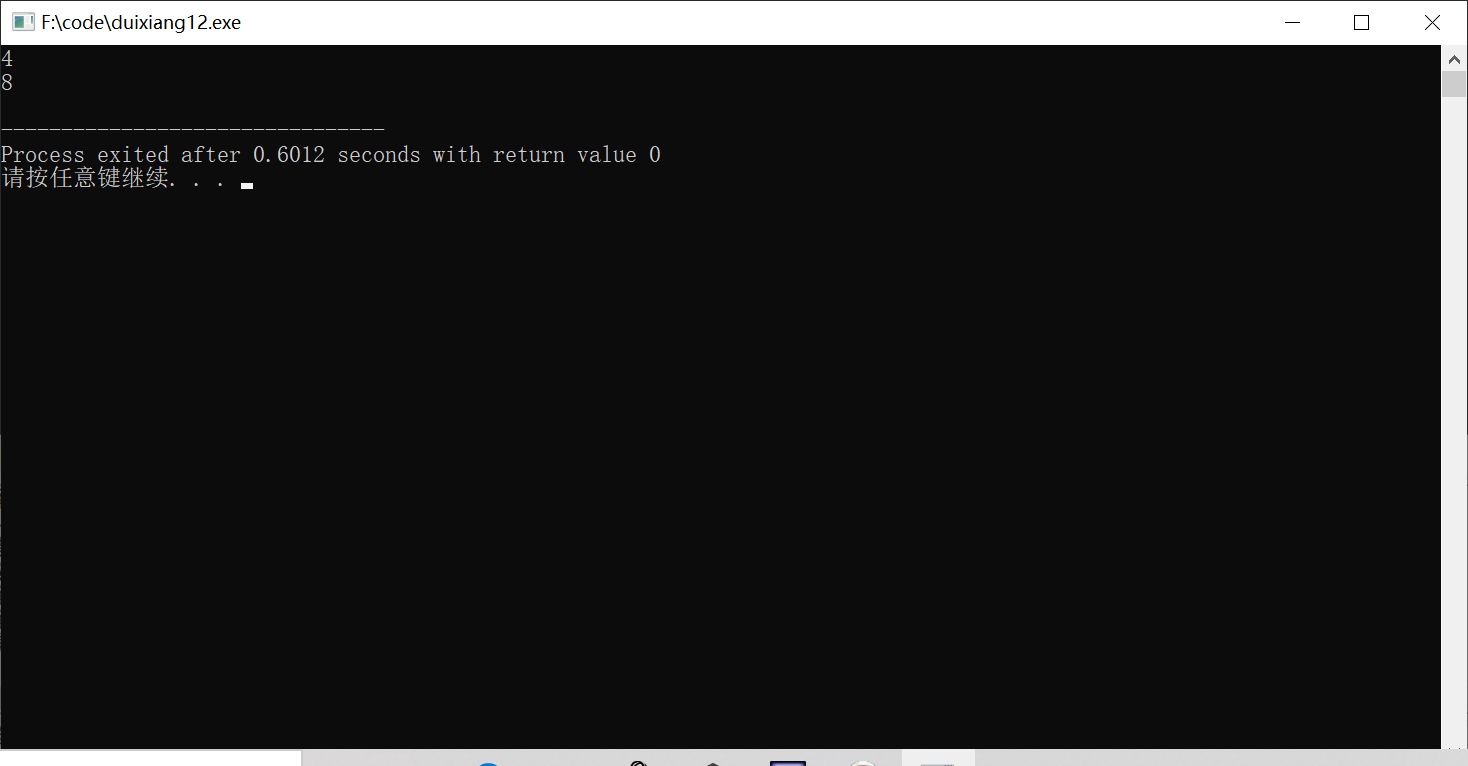
(10)this指针
this指针指向正在操作该成员函数的对象。
this指针最常用的两种情况:
①该函数的返回的是对调用该函数的对象的引用 即return *this
②当参数与成员变量名相同时,由于参数优先,所以对数据成员必须显式使用this指针修饰。
//this指针 #include<iostream> #include<cstdio> using namespace std; class Point { private: int x,y; public: Point(int xx,int yy) { x=xx;y=yy; } Point& setPoint(int x,int y) { this->x=x+8; (*this).y=y+8; return *this; } int getX(){return x;} int getY(){return y;} }; int main() { Point p1(8,8); cout<<"执行setPoint()前p1:"<<p1.getX()<<","<<p1.getY()<<endl; //cout<<p1.setPoint(8,8);这行是错的 p1.setPoint(8,8); //p1=p1.setPoint(8,8);和上一行等价 cout<<"执行setPoint()后p1:"<<p1.getX()<<","<<p1.getY()<<endl; return 0;
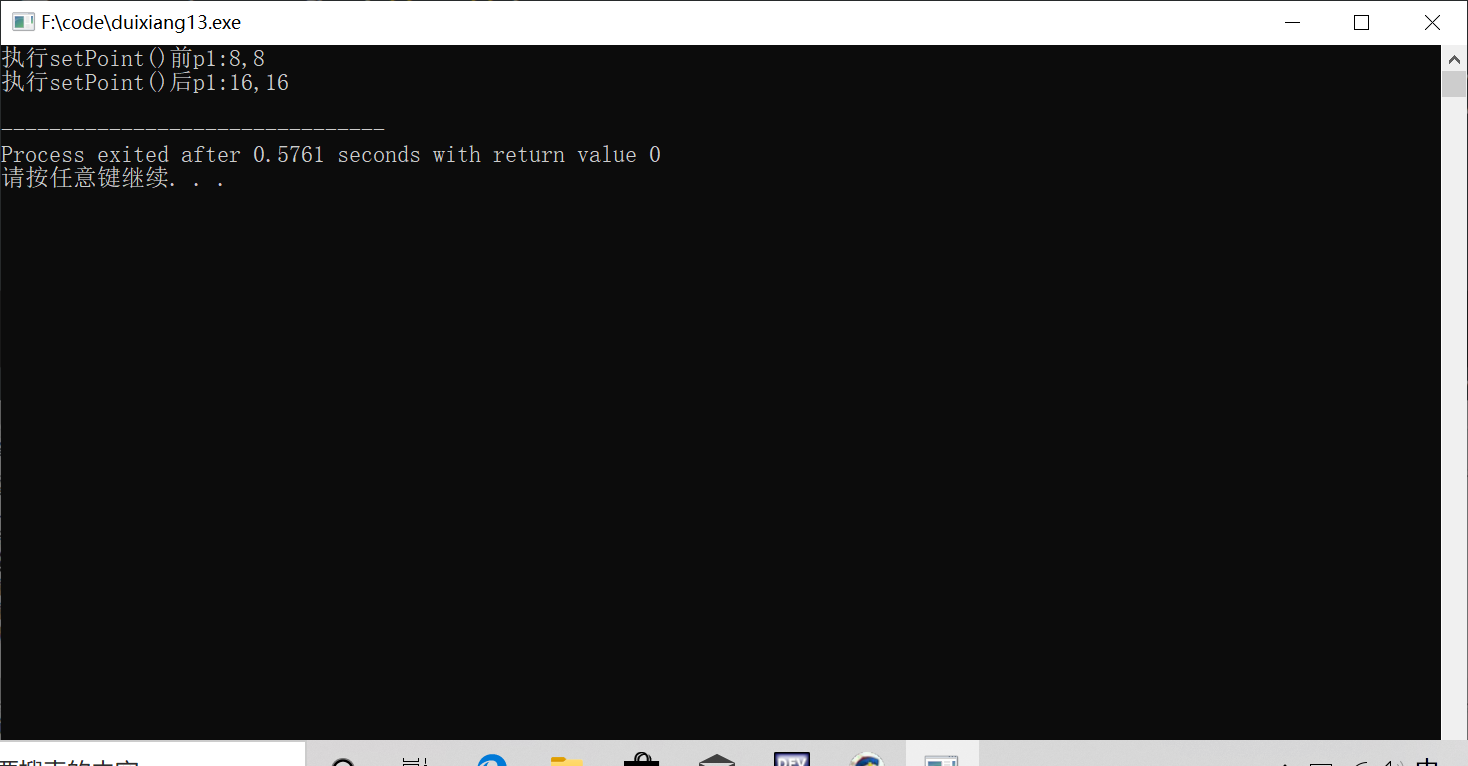
(11)常对象
常对象是指对象的数据成员的值不能被改变,常对象必须在定义的同时进行初始化。
且一旦定义就不能再改变。常对象只能调用const成员函数。普通对象可以调用const成员函数。
//常对象 #include<iostream> #include<cstdio> using namespace std; class Rectangle { private: int width; int length; public: Rectangle() { width=0; length=0; } Rectangle(int w,int len) { width=w;length=len; } int area() const { return width*length; } }; int main() { Rectangle r1(2,2); const Rectangle r2(6,8); //Rectangle const r2(6,8);等价 cout<<"r1的面积:"<<r1.area()<<endl; cout<<"r2的面积:"<<r2.area()<<endl; return 0; }
常对象中的某个数据成员想要修改,则声明为mutable
//常对象 #include<iostream> #include<cstdio> using namespace std; class Rectangle { private: int width; mutable int length; public: Rectangle() { width=0; length=0; } Rectangle(int w,int len) { width=w;length=len; } int area() const { length*=2; return width*length; } }; int main() { Rectangle r1(2,2); const Rectangle r2(6,8); //Rectangle const r2(6,8);等价 cout<<"r1的面积:"<<r1.area()<<endl; cout<<"r2的面积:"<<r2.area()<<endl; return 0; }
指向常对象的指针变量
const 类名 *指针变量名
const Rectangle *ptr=&r1;
不能通过ptr修改r1,但ptr也可以指向别的。
(12)常数据成员
将数据成员声明为const型。不能被赋值,类体类外函数只可读。
对常数据成员的初始化用构造函数的初始化列表。
const int Length; Rectangle(int w,int len):Length(len) {Width=w;}
(13)常成员函数
这些函数只是可读函数,不改变类的数据成员,对函数加上const关键字标识,提高程序的可读性。
#include<iostream> #include<cstdio> using namespace std; class Rectangle { private: int width,length; public: Rectangle(int w,int len) { width=w; length=len; } int area()const; void print() { cout<<"print"<<endl; } }; int Rectangle::area()const { //width=10;不可修改数据成员 //print();常成员函数不能调用非const型成员函数 return width*length; } int main() { Rectangle r(6,8); cout<<r.area()<<endl; return 0; }
(14)常指针
将指针变量声明为const,这样指针始终保持其初值,不会改变。
#include<iostream> #include<cstdio> using namespace std; class Rectangle { private: int width,length; public: Rectangle(int w,int len) { width=w; length=len; } int area() { return width*length; } }; int main() { Rectangle r1(6,6); Rectangle *const ptr=&r1; cout<<ptr->area(); // Rectangle r2(3,3);不可以改变常指针的值 // ptr=&r2; return 0; }
(15)常引用
一个变量的引用就是这个变量的别名。
变量名和引用名都指向同一段内存单元。
如果形参为变量的引用名,实参为变量名,则在调用时虚实结合,
并不是为形参新开辟了空间,而是把实参变量地址传给形参。
如果不希望在函数中修改实参的值,则可以把引用变量名声明为常引用。
#include<iostream> #include<cstdio> using namespace std; class Rectangle { private: int width,length; public: Rectangle(int w,int len) { width=w; length=len; } void setWL(int w,int len) { width=w; length=len; } int area() { return width*length; } }; void setRec(Rectangle &r1) { r1.setWL(2,2); } int main() { Rectangle r(6,8); cout<<r.area()<<endl; setRec(r); cout<<r.area()<<endl; return 0; }
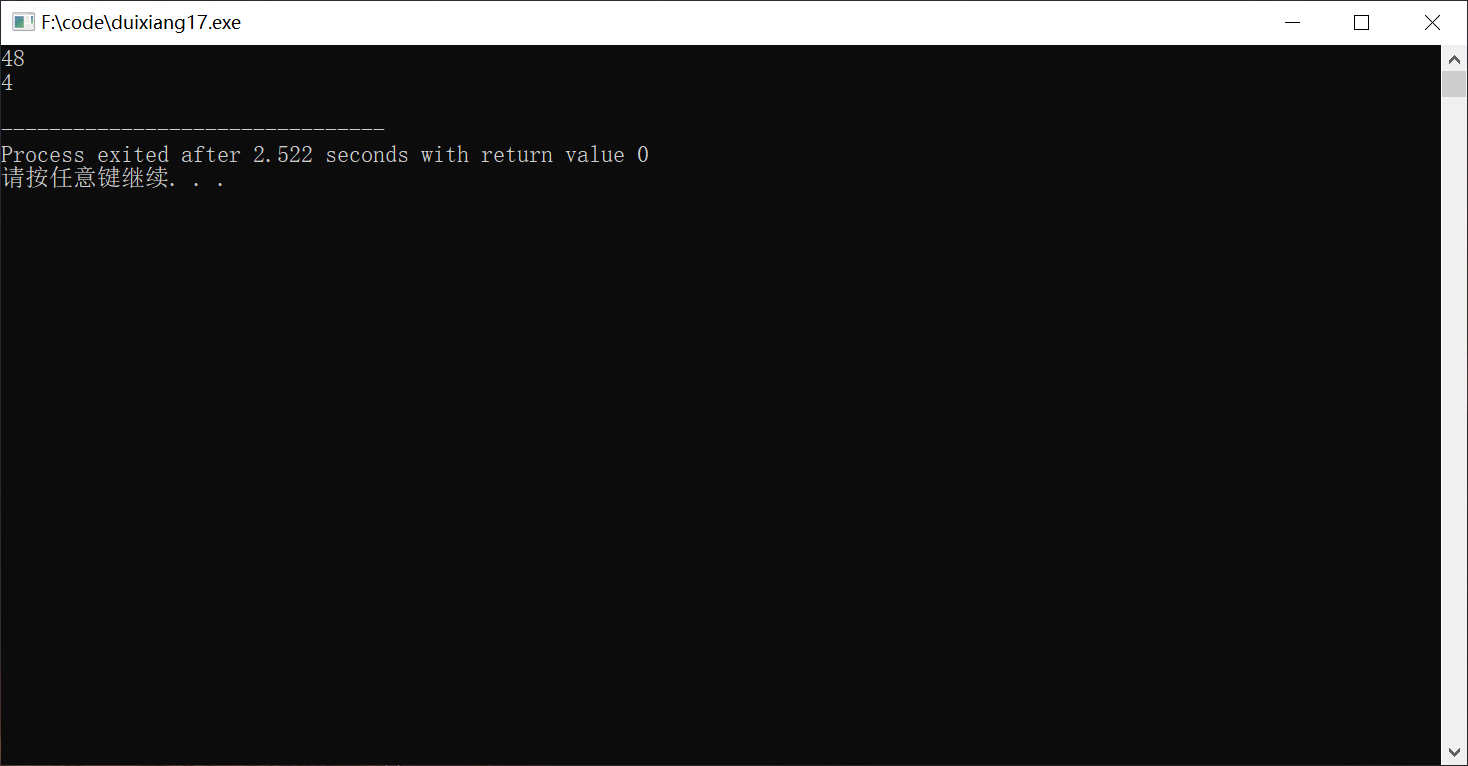
若是常引用,则不可以修改。

(16)友元
c++用关键字 friend声明类的友元
①位于一个函数说明语句之前,指出该函数为这个类的友元函数。
②位于一个类名之前,指出该类是这个类的友元。
如果要允许一个不属于类的函数取该类中的数据
法一:数据成员声明为共有
法二:将类内部声明这个函数为友元,可以访问该类数据。
后者更好。友元其实破坏了类的封装。
友元函数是普通(全局)函数
//友元 #include<iostream> #include<cstdio> using namespace std; class Rectangle { private: int width,length; public: Rectangle(int w,int len) { width=w; length=len; } int area() { return width*length; } friend void display(Rectangle &r1); }; void display(Rectangle &r1)//必须要加& { cout<<r1.length<<" "<<r1.width<<endl;//不能直接使用length必须通过对象使用 cout<<r1.area()<<endl; } int main() { Rectangle r(6,8); display(r); return 0; }
友元函数是其他类的成员函数
#include<iostream> #include<cstdio> using namespace std; class Rectangle;//提前引用说明 class Cuboid { private: int Height; public: Cuboid(int h) { Height=h; } int Volume(Rectangle &r);//此处只能声明,不能定义。因为Rectangle类还未定义 }; class Rectangle { private: int width,length; public: Rectangle(int w,int len) { width=w;length=len; } friend int Cuboid::Volume(Rectangle &r); }; int Cuboid::Volume(Rectangle &r) { return r.length*r.width*Height; } int main() { Rectangle R(6,8); Cuboid C(20); cout<<"长方体的体积为:"<<C.Volume(R)<<endl; return 0; }
(17)友元类
C++中允许将一个类声明为另一个类的友元,称为友元类。友元类中的所有成员
函数都可以访问另一个类中的私有成员或保护乘员
#include<iostream> #include<cstdio> using namespace std; class Rectangle; class Cuboid { private: int Height; public: Cuboid(int h) { Height=h; } int Volume(Rectangle &r); }; class Rectangle { private: int width,length; public: Rectangle(int w,int len) { width=w; length=len; } friend class Cuboid; }; int Cuboid::Volume(Rectangle &r) { return r.length*r.width*Height; } int main() { Rectangle r(6,8); Cuboid C(20); cout<<"长方体的体积为:"<<C.Volume(r); return 0; }
(18)类模板
看不下去了。直接抄。
class A { private: int x,y; public: A(int xx,int yy){x=xx;y=yy;} int sum(){return x+y;} }; class A { private: double x,y; public: A(double xx,double yy){x=xx;y=yy;} double sum(){return x+y;} };
两段代码只是数据类型不同,但做的工作是重复的。
类模板是一系列相关类的模型或样板,这些类的成员组成相同,成员函数的源代码形式相同。所不同的只是类型。
(成员的类型以及成员函数的参数类型)。对于类模板,数据类型成了它的参数,因而是一种类型参数化的类。
类模板是类的抽象,类是类模板的实例。
template<class T> class A { private: T x,y; public: A(T xx,T yy){x=xx;y=yy;} T sum(){return x+y;} };
template<模板参数表>
class 类模板名
{}
class也可用typename关键字代替
类模板不能直接生成对象,因为其参数类型是不确定的,故需要首先对模板参数指定“实参”
类模板名<具体类型>对象名{(构造函数实参列表)}
A<int>IntA(6,8);
A<double>DoubleA(6.6,8.8)
若函数在类外定义
T A<T>::sum()
{return x+y;}